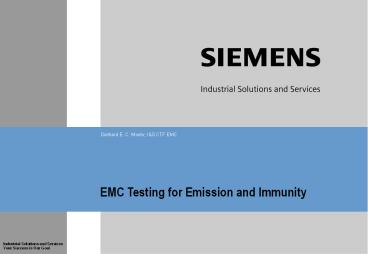EMC Testing for Emission and Immunity PowerPoint PPT Presentation
Title: EMC Testing for Emission and Immunity
1
EMC Testing for Emission and Immunity
Diethard E. C. Moehr, IS CTF EMC
2
Measurement procedure according to CISPR 16, Part
1 (VDE 0877 Part 1 and 2)
- Measurement procedure for conducted emission on
power lines and on data and signal lines - VDE 0877, Part 1 (CISPR 16 - 1)
- Measurement procedure for radiated emission
- electrical field
- VDE 0877, Part 2 (CISPR 16 - 1)
3
Measuring Standards on EMC
Emission
- The measuring standards for emission are product
related. This means that there are standards
designated to special products or product
groups. - The measuring standards for immunity are
phenomena related. This means that different
immunity phenomena have to be tested independent
of the product group.
Immunity
4
Measuring equipment needed for emission
measurements
Conducted emission 10 kHz - 30 MHz
- LISNs
- Screened Rooms
- Measuring receivers with Average and CISPR
detectors - Auxiliary measuring equipment
Radiated emission 30 MHz - 1 GHz
- OATS with field attenuation according to CISPR
16 and VDE 0877, Part 2 - Measuring receivers with Average and CISPR
detectors - Auxiliary measuring equipment
5
Measuring procedure for radiated emission
- Measuring distance 10 meters
- No ambient noise
- OATS according to CISPR 16 and VDE 0877 Part 2
- EUT emission maximum has to be recorded
- 360 turning of the turntable
- Altitude variation of the receiving antenna 1 - 4
meter - Horizontal vertical polarization
- Install the EUT like in reality
6
Measuring procedure for radiated emission
7
Measuring procedure for conducted emission -
Part 1
Measure in cm
DIN VDE 0877, Part 1
- 1 metal sheet 2 m x 2 m
- 2 EUT
- 3 bundled cable
- 4 LISN
- 5 shielded interconnection cable
- 6 measuring receiver
- B earthing point
- M connection to measuring receiver
- P connection EUT
Measuring set up for an EUT supplied by public
mains
8
Measuring procedure for conducted emission -
Part 2
DIN VDE 0877, Part 2
Measure in cm
1 metal sheet 2 m x 2 m 2 EUT 3 power supply
cable 4 separate connection cable 5 LISN 6 touchab
le metal surface of the EUT A connection power
supply B connection earthing point P connection
EUT H connection artificial hand M connection
measuring receiver D metal foils ground separate
from power supply
EUT with artificial hand
9
Measuring procedure for conducted emission -
Part 3
Measure in cm
DIN VDE 0877, Part 3
1 metal sheet 2 m x 2 m 2 EUT (Fax
machine) 3 power supply 4 communication
cable 5 V - LISN 6 - LISN 7 measuring
receiver B earthing point M connection to
measuring receiver P connection EUT
Measuring set up for an EUT with different supply
cables
10
Immunity phenomena
ESD
- Rubbing or heating up of non conductive
materials - Triboelectric effect
RFI
- Radio TV stations
- Walkie talkies
- Wireless communication
- Mobile phones and others
11
Immunity phenomena
BURST
- All electrical switches
- Contactors
- Fluorescent lights and other gas discharge
devices
SURGE
- Lighting
- Switching of large Loads
COND. IMMUNITY
- Coupling of sinusoidal disturbances into cables
12
Measuring equipment neededfor immunity tests
ESD
ESD Simulator
RFI
Transmitting antennas, generators, power
amplifiers,anechoic chambers, field sensors and
other auxillary equipment
BURST
BURST simulator and coupling clamps and devices
SURGE
SURGE simulator and coupling clamps and devices
CONDUCTED IMMUNITY
Generators, coupling / decoupling networks (CDNs)
For all immunity tests it is at least
recommended to use shielded rooms.
13
Immunity test procedures
ESD
Electrostatic discharge
14
The Triboelectric Effect
- The reason for the discharge of static
electricity is the Triboelectric Effect. - Non conductive material have the tendency to
build up static electricity if they are rubbed
against each other or if they are heated up.
Air Artificial resin Glass Nylon Hair Silk Cotton
Wood, Paper Amber Polyurethane Polyethylene Rubber
PVC Silicon Teflon
15
The Triboelectric Effect-2
16
Typical output current waveshapeof a human body
discharge
17
Typical output current waveshapeof the ESD
simulator
18
Test Waveforms in IEC Standards -- Time Waveforms
19
Test Waveforms in IEC Standards -- Frequency
Spectra
20
Circuit diagram of the ESD simulator
21
Measuring set up for verification of the ESD
pulse (direct contact of the discharge tip)
22
Immunity test procedures
RFI
Immunity against radiated fields
23
Setup for radiated field testing
24
Immunity test procedures
BURST
Low energy fast transients
25
Low energy fast transients Part 1
Sources of Noise
Coupling mechanism
Receptors
- Power switches vacuum relays,contactors,
relaysand others - protective devices (fuses, gas discharges and
others) - electrical motors with brushes like in vacuum
cleaners, hair dryer and motors in industrial
applications
- Electrical and electronic devices of any kind
- Power linesdata linessignal linescommunication
lines
Principle of source ? coupling ? receptors
applied to low energy fast transients (BURST).
26
Low energy fast transients Part 2Test levels for
BURST testing
27
Low energy fast transients Part 3Principle of
the BURST generator
28
Low energy fast transients Part 4BURST impulse
package
29
Low energy fast transients Part 5Single BURST
pulse
30
Immunity test procedures
SURGE
High energy transients
31
SURGE testing Part 1
Circuit diagram of the generator
(combinationwave generator)
32
SURGE testing Part 2
Pulse shape of open circuit voltage according to
IEC 60060-1
33
SURGE testing Part 3
Pulse shape of the short circuit current
according to IEC 60060-1
34
SURGE testing Part 4
Pulse shape of the open circuit voltage according
to CCITT
35
SURGE testing Part 5
Coupling network for SURGE pulses for a. c. and
d. c. mains
36
SURGE testing Part 6
Recommended test levels according to IEC 61000-4-5
37
Comparison of ESD, BURSTand SURGE tests
38
Contact Diethard Moehr IS CTF EMC Schuhstraße
60 D-91052 Erlangen Phone 49 (9131)
7-27210Mail diethard.moehr_at_siemens.com
Thank you very much for your attention.

